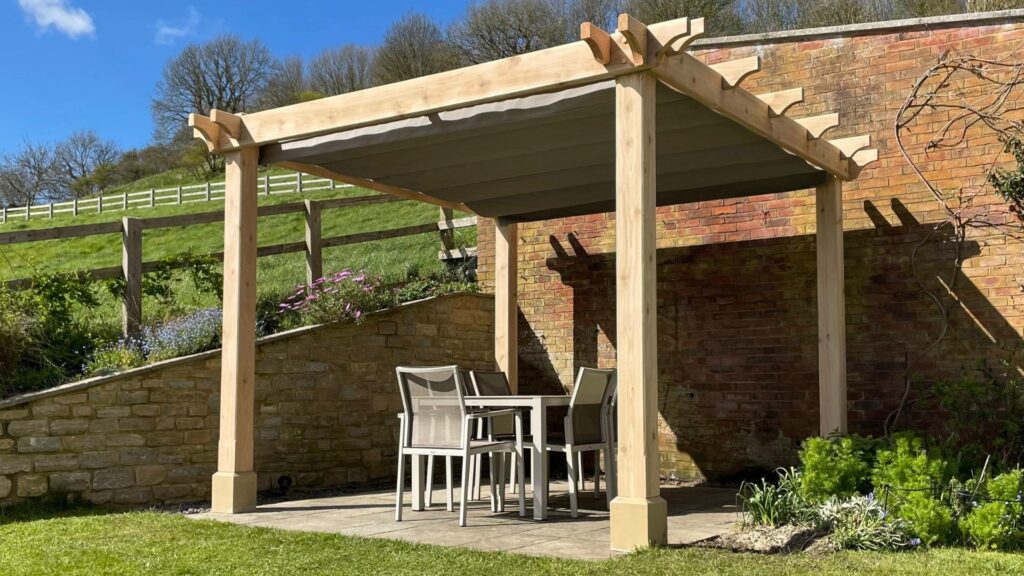Originally published in June 2022

A pergola is an excellent addition to any property, providing a beautiful outdoor space and extending the period during which you can comfortably relax outside, even into the summer months. For some, a well-designed pergola can create an area suitable for use throughout the year. The most effective solutions offer a spacious area that can accommodate a patio set, seating area, or both. When considering a pergola, there are several factors to keep in mind, but these four are a good starting point. Additionally, you can find more general information about pergolas on our FAQ page
- Planning Permission
We have a lot of permitted development rights in the UK and, in most cases, there will not be any restrictions to building a pergola if some simple points are followed.
- You are not allowed to site a pergola in front of your house or at the side between the house and the boundary fence.
- Half of the garden area of your original house is not already covered by a garden building(s). Note – Original house means exactly that before any extensions or alterations are taken into account.
- If your chosen site is within 2m of your boundary fence then you are restricted to 2.5m as the maximum height of your pergola. This is probably an ideal height for most properties and allows tall people 1.83m (6ft) to pass underneath easily.
- If you can move the position of your pergola to greater than 2m from your boundary you are allowed to build up to 3m in height which can create an impressive structure in the right setting.
- In conservation areas the restrictions above still apply but, additionally, if you want to build further than 20m from your house you are restricted to a maximum size of 10m2 before you need to apply for planning permission.
- If your building is listed you must always apply for planning permission.
- If you are unsure, it is always best to check with a quick call to your local planning office.
Depending on where you live, you may need to obtain planning permission before constructing a pergola. Be sure to check with your local authorities to understand the regulations in your area.
- Location, Location, Location
You may already have the perfect spot in mind for the pergola – is it the patio, lawn, or next to the pool? You will have thought about the best place to catch the best of the sunshine, but have you considered any services or utilities that pass under the area? This is crucial as the foundation/base of your posts will need to be in the ground or ideally attached to it. For example we only use decorative stone bases or concealed stone base on a hard patio tor pad to lift the base of the pergola off the ground to extend its life. Although all services and utilities should be installed at a safe depth, it’s always best to check before breaking ground, as it’s not only dangerous but expensive to repair any water or gas pipes, electricity or fiber cables, or surface water or sewage drains. You may have this information in the documents when you purchased your house or had building work approved. If not, your local utility company should assist with your query.
- Materials & Finish
Most pergolas are constructed from either wood or aluminum, each material offering distinct design aesthetics and providing a sturdy, stable framed structure. Wooden pergolas offer more flexibility in terms of material choice and finish options. We use locally grown Cedar and Oak from the New Forest and Dorset area as our preferred choice, but it is crucial to ensure that the wood meets the appropriate durability and use class standards for external frames.
On the other hand, aluminum frames can be more durable if they feature a good protective coating to prevent oxidation. However, as a soft metal, a poorly designed aluminum pergola will degrade over time quicker than correctly built pergola. Wooden pergolas can provide a beautiful and elegant natural finish or a modern look with fresh colors and shades to complement outdoor furniture.
When choosing a material, it is important to consider its sustainability and origin. Is the material sourced from sustainable sources within the UK, Europe, or imported from farther afield? It is worth noting that imported timber grown in a different climate than the UK’s may be more prone to surface cracks (shakes) and twisting as it acclimatizes to local weather conditions.
- Sun, Rain & Privacy Protection
Sun, Rain & Privacy Protection: A well-designed pergola offers a stylish outdoor living space, allowing you to make the most of favorable weather conditions in the UK, regardless of the season. While the pergola frame itself is ideal for enjoying fine weather, it provides minimal protection from the sun’s heat or rainfall, often forcing you to retreat indoors to stay cool or dry. However, a bespoke shade solution can provide comprehensive protection from both the sun and rain, ensuring you can continue to enjoy your pergola throughout the year. Additionally, these shades offer enhanced privacy, creating a secluded and comfortable outdoor haven.
Building a pergola can be an excellent way to create an inviting outdoor space for relaxation and entertainment, while potentially increasing the value of your property. You have the option to purchase a pre-made pergola or engage our services to design and construct a truly customised pergola with a waterproof retractable shade, tailored to your specific needs and preferences. Regardless of the route you choose, it is advisable to consider the tips to ensure the successful creation of your dream pergola. Our team is readily available to provide any additional information or guidance you may require throughout the process.
Contact Hampshire Shades on 01489 290 025 or ‘Book a Discovery Call’ for a bespoke, luxury, covered pergola with a retractable waterproof roof.

